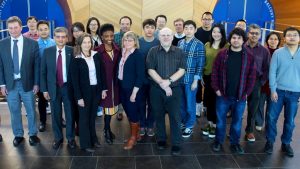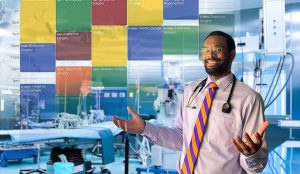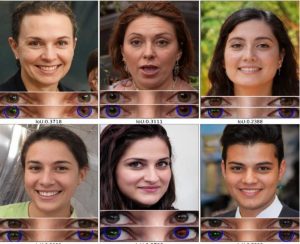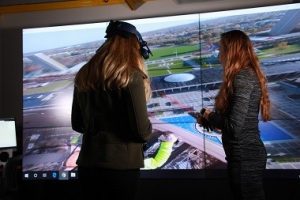The Research Connection – May, 2021: Artificial Intelligence/Machine Learning Edition
Featured university R&D projects:
- The Rensselaer-IBM Artificial Intelligence Research Collaboration
- Combating Fake News with Artificial Intelligence
- Combining Neuroimaging and Artificial Intelligence to Help Veterans
- Applying AI Research to COVID reopening plans
- Empowering Health Care Facilities to Monetize Efficiency
- A New Tool to Detect Deepfakes
- AI-Guided Robots Potential Solution for Plastic Pollution Problem
- Using AI to Optimize Food-Drug Interactions
- Advancing AI Solutions for Winter Weather
- Making Sense of a Massive Data Set
This edition’s contributors:
- SUNY Research Foundation: University at Albany, SUNY Polytechnic Institute, University at Buffalo
- Rensselaer Polytechnic Institute
The Rensselaer-IBM Artificial Intelligence Research Collaboration
 The Rensselaer-IBM Artificial Intelligence Research Collaboration (AIRC) is a multiyear, joint effort between Rensselaer Polytechnic Institute and IBM that involves multiple graduate students, postdocs, research scientists, and faculty working closely with IBM researchers to push the frontiers of AI research and apply their results to some of the world’s key global challenges. The AIRC is part of the AI Horizons Network, which brings together IBM researchers, world-class faculty, and top graduate students to collaborate on a series of advanced research projects and experiments designed to accelerate the application of artificial intelligence, machine learning, natural language processing, and related technologies. AIRC projects are designed to apply the technologies to some of the world’s most enduring challenges, ranging from disease and the environment to transportation and education.
The Rensselaer-IBM Artificial Intelligence Research Collaboration (AIRC) is a multiyear, joint effort between Rensselaer Polytechnic Institute and IBM that involves multiple graduate students, postdocs, research scientists, and faculty working closely with IBM researchers to push the frontiers of AI research and apply their results to some of the world’s key global challenges. The AIRC is part of the AI Horizons Network, which brings together IBM researchers, world-class faculty, and top graduate students to collaborate on a series of advanced research projects and experiments designed to accelerate the application of artificial intelligence, machine learning, natural language processing, and related technologies. AIRC projects are designed to apply the technologies to some of the world’s most enduring challenges, ranging from disease and the environment to transportation and education.
Potential Applications: AI research and innovation
Contact: Reeve Hamilton, hamilr5@rpi.edu
Combating Fake News with Artificial Intelligence
 Warnings about misinformation are now regularly posted on Twitter, Facebook, and other social media platforms, but not all of these cautions are created equal. New research from Rensselaer Polytechnic Institute shows that artificial intelligence can help form accurate news assessments — but only when a news story is first emerging. These findings were recently published in Computers in Human Behavior Reports by an interdisciplinary team of Rensselaer researchers. They found that AI-driven interventions are generally ineffective when used to flag issues with stories on frequently covered topics about which people have established beliefs, such as climate change and vaccinations. However, when a topic is so new that people have not had time to form an opinion, tailored AI-generated advice can lead readers to make better judgments regarding the legitimacy of news articles.
Warnings about misinformation are now regularly posted on Twitter, Facebook, and other social media platforms, but not all of these cautions are created equal. New research from Rensselaer Polytechnic Institute shows that artificial intelligence can help form accurate news assessments — but only when a news story is first emerging. These findings were recently published in Computers in Human Behavior Reports by an interdisciplinary team of Rensselaer researchers. They found that AI-driven interventions are generally ineffective when used to flag issues with stories on frequently covered topics about which people have established beliefs, such as climate change and vaccinations. However, when a topic is so new that people have not had time to form an opinion, tailored AI-generated advice can lead readers to make better judgments regarding the legitimacy of news articles.
Potential Applications: Media literacy, public awareness
Contact: Jeanne Hedden Gallagher, gallaj3@rpi.edu
Combining Neuroimaging and Artificial Intelligence to Help Veterans
 Triage care on the battlefield requires split-second decision making and proficiency in providing first aid. Correctly applying a tourniquet or inserting an intubation tube before a patient is evacuated to a hospital could save lives. To improve training for the field medics responsible for this level of care, researchers at Rensselaer Polytechnic Institute have teamed up with researchers from the United States Army Research Laboratory in Orlando, Florida, to better understand skill acquisition and to standardize the prolonged field care (PFC) certification process. With the support of a $3.1 million grant from the U.S. Army Combat Capabilities Development Command Soldier Center, the team will combine neuroimaging, computer vision, eye-tracking, and artificial intelligence methods to make PFC certification faster, more objective, and scalable for all soldiers. Their first step will be to create an AI-enabled system for automatically and accurately evaluating performance. Data that includes hand motions captured by cameras, eye movement captured by gaze tracking, and brain activity captured by neuroimaging will be integrated into AI models that automatically classify performance.
Triage care on the battlefield requires split-second decision making and proficiency in providing first aid. Correctly applying a tourniquet or inserting an intubation tube before a patient is evacuated to a hospital could save lives. To improve training for the field medics responsible for this level of care, researchers at Rensselaer Polytechnic Institute have teamed up with researchers from the United States Army Research Laboratory in Orlando, Florida, to better understand skill acquisition and to standardize the prolonged field care (PFC) certification process. With the support of a $3.1 million grant from the U.S. Army Combat Capabilities Development Command Soldier Center, the team will combine neuroimaging, computer vision, eye-tracking, and artificial intelligence methods to make PFC certification faster, more objective, and scalable for all soldiers. Their first step will be to create an AI-enabled system for automatically and accurately evaluating performance. Data that includes hand motions captured by cameras, eye movement captured by gaze tracking, and brain activity captured by neuroimaging will be integrated into AI models that automatically classify performance.
Potential Applications: military training, medical training
Contact: Torie Wells, buckv@rpi.edu
Applying AI Research to COVID Reopening Plans
 Buffalo Automation is setting a new course that could help organizations around the world better navigate return-to-work plans amid the COVID-19 pandemic. The University at Buffalo spinout adapted its system that uses thermal imaging technology to enable ships and boats to essentially drive themselves to streamline the process of taking body temperatures in the workplace.
Buffalo Automation is setting a new course that could help organizations around the world better navigate return-to-work plans amid the COVID-19 pandemic. The University at Buffalo spinout adapted its system that uses thermal imaging technology to enable ships and boats to essentially drive themselves to streamline the process of taking body temperatures in the workplace.
The Bifrost system takes specific human features from thermal images and measures the skin temperatures from areas most likely to indicate a fever. By taking the temperatures of multiple people simultaneously, Buffalo Automation hopes to simplify a tedious and expensive process that requires trained personnel and often results in people having to wait in line — thus saving time and money. Explore partnership opportunities.
Potential applications: This technology will augment reopening plans and ensure the safety and well-being of workers, customers, and visitors.
Contact: Thiru Vikram, CEO, https://www.linkedin.com/in/thiruvikram/
Empowering Health Care Facilities to Monetize Efficiency
 The average operating room (OR) costs $1,200 per hour to operate. Less than half of surgeries in the U.S. start and end at their scheduled times and the overall price of the resulting scheduling chaos is more than $14 billion per year. University at Buffalo spinout Opollo Technologies offers an innovative AI solution that leverages existing data to improve the OR’s efficiency and operating logistics.
The average operating room (OR) costs $1,200 per hour to operate. Less than half of surgeries in the U.S. start and end at their scheduled times and the overall price of the resulting scheduling chaos is more than $14 billion per year. University at Buffalo spinout Opollo Technologies offers an innovative AI solution that leverages existing data to improve the OR’s efficiency and operating logistics.
Opollo™ is a machine-learning algorithm that uses medical natural language processing to provide two to three times more accurate surgery duration forecasts than existing methods. The cloud-based AI platform learns from a wide range of health care data to optimize operating room scheduling, allowing hospitals and ambulatory surgery centers to maximize revenue and reduce costs. Explore partnership opportunities.
Potential applications: Fin Tech, Health Care
Contact: Ryan Young, Founder and CEO, https://www.opollo.ai/contact
A New Tool to Detect Deepfakes
 Deepfakes, manipulated digital content produced by advanced artificial intelligence, can cause serious societal harm. University at Buffalo computer scientists have developed a tool that automatically identifies deepfake photos by analyzing light reflections in the eyes.
Deepfakes, manipulated digital content produced by advanced artificial intelligence, can cause serious societal harm. University at Buffalo computer scientists have developed a tool that automatically identifies deepfake photos by analyzing light reflections in the eyes.
The tool, which proved 94% effective with portrait-like photos according to a recent study, works by mapping out each face. It then examines the eyes, followed by the eyeballs and lastly the light reflected in each eyeball. It compares in incredible detail potential differences in shape, light intensity and other features of the reflected light. Support this research, collaborate with the research team.
Potential applications: Cybersecurity
Contact: Siwei Lyu, SUNY Empire Innovation Professor, Siweilyu@buffalo.edu
AI-Guided Robots Potential Solution for Plastic Pollution Problem
 University at Buffalo researchers are developing a novel set of tools that aim to improve the nation’s plastic recycling efforts. This includes a robotic system that will combine novel sensor technology that can register the molecular signature of each piece of plastic, and machine learning that, on the basis of these molecular signatures, identifies in real-time the specific type of each piece of plastic.
University at Buffalo researchers are developing a novel set of tools that aim to improve the nation’s plastic recycling efforts. This includes a robotic system that will combine novel sensor technology that can register the molecular signature of each piece of plastic, and machine learning that, on the basis of these molecular signatures, identifies in real-time the specific type of each piece of plastic.
By integrating this system with existing technologies, researchers aim to create an advanced mixed waste sorting process that also captures and reuses other materials often found in plastic recycling streams, such as contaminants and non-polymeric waste, that make recycling difficult and expensive. Recapturing value from end-of-life plastic materials can help push the U.S. and other nations toward the long-term goal of creating a circular economy for plastics. Support this research, collaborate with the research team.
Potential applications: Advanced manufacturing, recycling, environmental remediation
Contact: Paschalis Alexandridis, UB Distinguished Professor, palexand@buffalo.edu
Using AI to Optimize Food-Drug Interactions
 Consumers are confronted with an increasingly complex array of dietary and pharmaceutical choices that influence health and well-being. A research team led by SUNY Polytechnic Institute Technology Management Professor Dr. Robert Edgell found that while plenty of information about possible interactions among substances is available, many people struggle to make decisions that optimize ingestion or eating outcomes. Their solution: introducing AI as a decision-making tool to minimize negative interactions among medicines, foods, and other substances. The researchers have already outlined the key informational components needed to develop a comprehensive and effective AI decision-making system. Partner with the research team.
Consumers are confronted with an increasingly complex array of dietary and pharmaceutical choices that influence health and well-being. A research team led by SUNY Polytechnic Institute Technology Management Professor Dr. Robert Edgell found that while plenty of information about possible interactions among substances is available, many people struggle to make decisions that optimize ingestion or eating outcomes. Their solution: introducing AI as a decision-making tool to minimize negative interactions among medicines, foods, and other substances. The researchers have already outlined the key informational components needed to develop a comprehensive and effective AI decision-making system. Partner with the research team.
Potential Applications: Pharmaceuticals; healthcare management; nutrition and personal well-being; agriculture and food industries; outer space exploration and human health, safety, and welfare
Contact: Dr. Robert Edgell, Professor, Technology Management edgellr@sunypoly.edu
Advancing AI Solutions for Winter Weather
 Researchers at the University at Albany’s Atmospheric Sciences Research Center are using AI and machine learning techniques to improve our understanding of weather and climate. The research, supported by a $2.4 million National Science Foundation (NSF) grant, will lead to the development of technologies that will be used to better monitor and predict winter weather, as well as tailor tools that can be utilized for decision-making when severe winter storms are looming.
Researchers at the University at Albany’s Atmospheric Sciences Research Center are using AI and machine learning techniques to improve our understanding of weather and climate. The research, supported by a $2.4 million National Science Foundation (NSF) grant, will lead to the development of technologies that will be used to better monitor and predict winter weather, as well as tailor tools that can be utilized for decision-making when severe winter storms are looming.
As part of the NSF Institute for Research on Trustworthy AI in Weather, Climate and Coastal Oceanography, the UAlbany research team is combining resources with institutions across multiple sectors to discover and enhance innovative technologies that will improve weather-based decision making in New York, the United States and around the globe.
Call to Action: Partner with the research team.
Potential Applications: Smart weather decision-making to help businesses and industries operate more efficiently; increased resiliency to extreme weather events for utilities, transportation departments and other public sector services.
Contact: Christopher D. Thorncroft, Director, Atmospheric Sciences Research Center, cthorncroft@albany.edu
Making Sense of a Massive Data Set
 For decades, the U.S. Department of Energy (DOE) has collected millions of digital cloud particle images from under the wing of research aircrafts that are used during its observational field campaigns. A team of scientists at the University at Albany are now using $599,204 in DOE funding to create a database that makes sense of this massive dataset. It employs a novel classification scheme and uses the most recent and advanced hardware/software tools available.
For decades, the U.S. Department of Energy (DOE) has collected millions of digital cloud particle images from under the wing of research aircrafts that are used during its observational field campaigns. A team of scientists at the University at Albany are now using $599,204 in DOE funding to create a database that makes sense of this massive dataset. It employs a novel classification scheme and uses the most recent and advanced hardware/software tools available.
Once launched, each image in the database will include a characterized list of information including the date it was taken, the altitude, latitude/longitude, and environmental characteristics such as air temperature. Machine learning technologies are used to classify the particle by type, and other AI techniques will be used to extract particle properties, such as its shape and size. Partner with the research team.
Potential Applications: New methodologies to consolidate and characterize millions of cloud particle images; gain a better understanding of cloud formation and growth history; identifying short comings in weather and climate simulations.
Contact: Kara Sulia, Research Associate, Atmospheric Sciences Research Center, ksulia@albany.edu
About The Research Connection: The Research Connection is a quarterly feature in the Center for Economic Growth’s monthly, online newsletter, The CEG Indicator. This special feature highlights R&D being conducted by researchers at Capital Region colleges and universities and others throughout the SUNY system. The Research Connection spotlights academic R&D in CEG’s focus technology sectors: Nanotechnology and Semiconductors, Cleantech/Energy, Biotechnology, Advanced Materials, Population Health Technology and Information Technology.
Each edition of The Research Connection will highlight several research projects in a specific technology sector. The Research Connection will keep CEG investors (2,500+) and CEG Indicator subscribers (9,000+) informed on the cutting-edge R&D that is being conducted by SUNY and other academic researchers that could potentially transform their industries. It will also encourage collaboration, patent, licensing and other opportunities.
Don’t miss these insights into the trends that are shaping the Capital Region’s economy. Sign up for CEG’s e-news and follow us on:













